Childhood Education and Care: Case Study Analysis and Solutions
VerifiedAdded on 2020/03/07
|10
|1987
|82
Case Study
AI Summary
This assignment presents four case studies related to childhood education and care, each focusing on different forms of child abuse and neglect. The first case study examines physical neglect and emotional maltreatment experienced by a child named Tamara, and proposes strategies to address her health, hygiene, and diet issues. The second case study addresses potential sexual abuse of a child named Ace by his uncle, highlighting the importance of careful handling and reporting protocols. The third case study explores emotional maltreatment and physical neglect experienced by Grace, emphasizing the need for reporting to child safety services. The final case study shifts focus to an educator, Jon, and explores ethical concerns regarding his interactions with a specific group of children. The assignment emphasizes the importance of recognizing signs of abuse, implementing appropriate intervention strategies, and adhering to ethical practices in the field of childhood education and care, referencing relevant literature and legal frameworks like the Child Protection Act (1999).
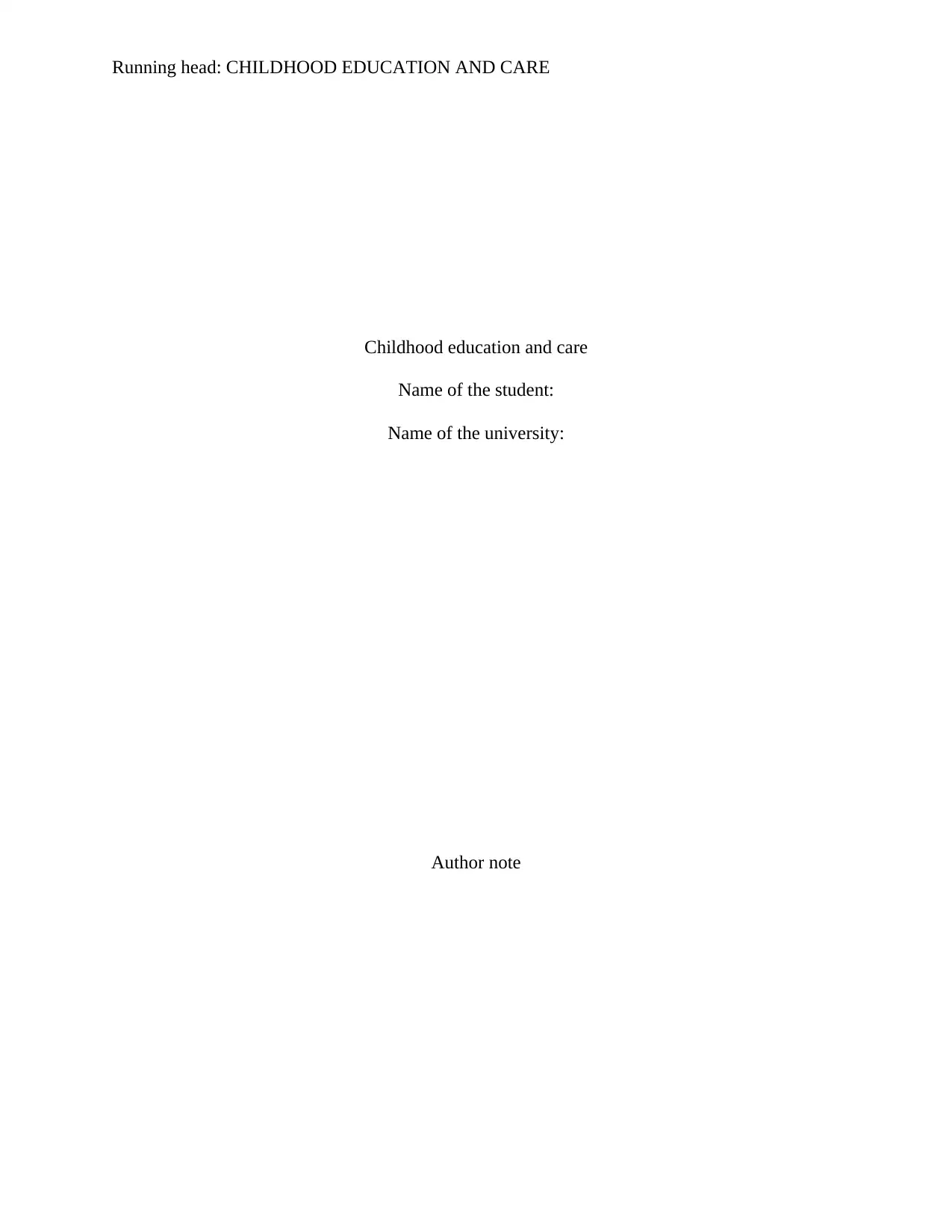
Running head: CHILDHOOD EDUCATION AND CARE
Childhood education and care
Name of the student:
Name of the university:
Author note
Childhood education and care
Name of the student:
Name of the university:
Author note
Paraphrase This Document
Need a fresh take? Get an instant paraphrase of this document with our AI Paraphraser
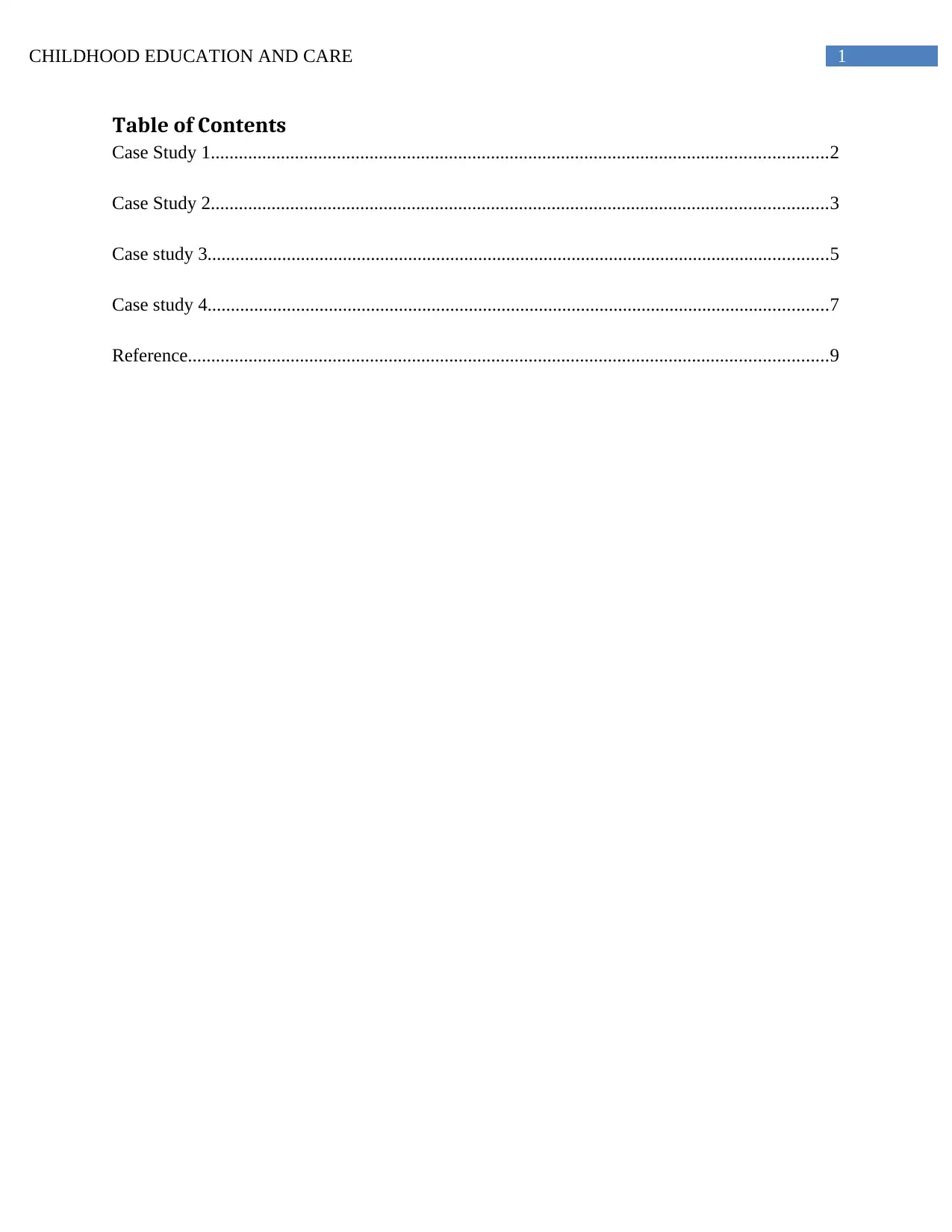
1CHILDHOOD EDUCATION AND CARE
Table of Contents
Case Study 1....................................................................................................................................2
Case Study 2....................................................................................................................................3
Case study 3.....................................................................................................................................5
Case study 4.....................................................................................................................................7
Reference.........................................................................................................................................9
Table of Contents
Case Study 1....................................................................................................................................2
Case Study 2....................................................................................................................................3
Case study 3.....................................................................................................................................5
Case study 4.....................................................................................................................................7
Reference.........................................................................................................................................9
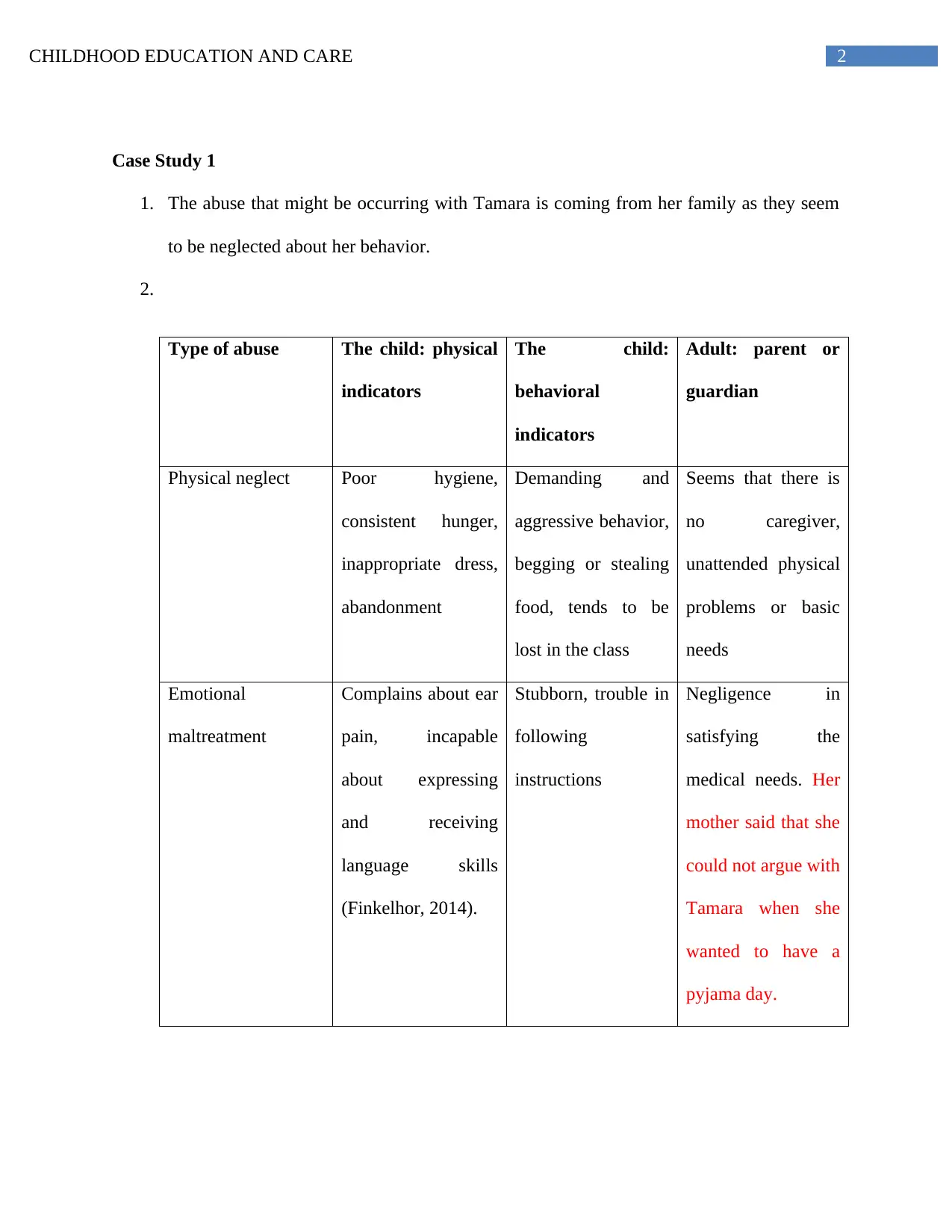
2CHILDHOOD EDUCATION AND CARE
Case Study 1
1. The abuse that might be occurring with Tamara is coming from her family as they seem
to be neglected about her behavior.
2.
Type of abuse The child: physical
indicators
The child:
behavioral
indicators
Adult: parent or
guardian
Physical neglect Poor hygiene,
consistent hunger,
inappropriate dress,
abandonment
Demanding and
aggressive behavior,
begging or stealing
food, tends to be
lost in the class
Seems that there is
no caregiver,
unattended physical
problems or basic
needs
Emotional
maltreatment
Complains about ear
pain, incapable
about expressing
and receiving
language skills
(Finkelhor, 2014).
Stubborn, trouble in
following
instructions
Negligence in
satisfying the
medical needs. Her
mother said that she
could not argue with
Tamara when she
wanted to have a
pyjama day.
Case Study 1
1. The abuse that might be occurring with Tamara is coming from her family as they seem
to be neglected about her behavior.
2.
Type of abuse The child: physical
indicators
The child:
behavioral
indicators
Adult: parent or
guardian
Physical neglect Poor hygiene,
consistent hunger,
inappropriate dress,
abandonment
Demanding and
aggressive behavior,
begging or stealing
food, tends to be
lost in the class
Seems that there is
no caregiver,
unattended physical
problems or basic
needs
Emotional
maltreatment
Complains about ear
pain, incapable
about expressing
and receiving
language skills
(Finkelhor, 2014).
Stubborn, trouble in
following
instructions
Negligence in
satisfying the
medical needs. Her
mother said that she
could not argue with
Tamara when she
wanted to have a
pyjama day.
⊘ This is a preview!⊘
Do you want full access?
Subscribe today to unlock all pages.

Trusted by 1+ million students worldwide
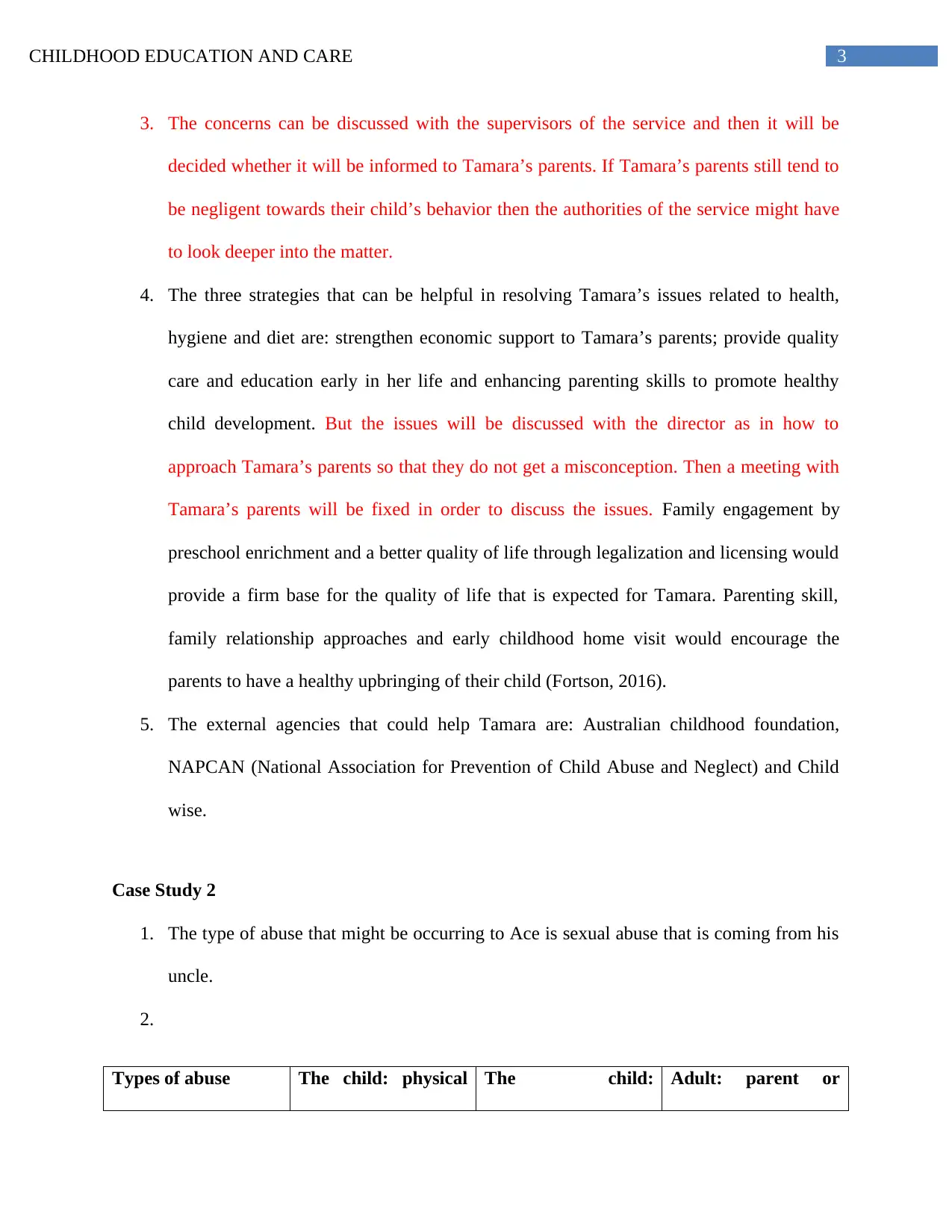
3CHILDHOOD EDUCATION AND CARE
3. The concerns can be discussed with the supervisors of the service and then it will be
decided whether it will be informed to Tamara’s parents. If Tamara’s parents still tend to
be negligent towards their child’s behavior then the authorities of the service might have
to look deeper into the matter.
4. The three strategies that can be helpful in resolving Tamara’s issues related to health,
hygiene and diet are: strengthen economic support to Tamara’s parents; provide quality
care and education early in her life and enhancing parenting skills to promote healthy
child development. But the issues will be discussed with the director as in how to
approach Tamara’s parents so that they do not get a misconception. Then a meeting with
Tamara’s parents will be fixed in order to discuss the issues. Family engagement by
preschool enrichment and a better quality of life through legalization and licensing would
provide a firm base for the quality of life that is expected for Tamara. Parenting skill,
family relationship approaches and early childhood home visit would encourage the
parents to have a healthy upbringing of their child (Fortson, 2016).
5. The external agencies that could help Tamara are: Australian childhood foundation,
NAPCAN (National Association for Prevention of Child Abuse and Neglect) and Child
wise.
Case Study 2
1. The type of abuse that might be occurring to Ace is sexual abuse that is coming from his
uncle.
2.
Types of abuse The child: physical The child: Adult: parent or
3. The concerns can be discussed with the supervisors of the service and then it will be
decided whether it will be informed to Tamara’s parents. If Tamara’s parents still tend to
be negligent towards their child’s behavior then the authorities of the service might have
to look deeper into the matter.
4. The three strategies that can be helpful in resolving Tamara’s issues related to health,
hygiene and diet are: strengthen economic support to Tamara’s parents; provide quality
care and education early in her life and enhancing parenting skills to promote healthy
child development. But the issues will be discussed with the director as in how to
approach Tamara’s parents so that they do not get a misconception. Then a meeting with
Tamara’s parents will be fixed in order to discuss the issues. Family engagement by
preschool enrichment and a better quality of life through legalization and licensing would
provide a firm base for the quality of life that is expected for Tamara. Parenting skill,
family relationship approaches and early childhood home visit would encourage the
parents to have a healthy upbringing of their child (Fortson, 2016).
5. The external agencies that could help Tamara are: Australian childhood foundation,
NAPCAN (National Association for Prevention of Child Abuse and Neglect) and Child
wise.
Case Study 2
1. The type of abuse that might be occurring to Ace is sexual abuse that is coming from his
uncle.
2.
Types of abuse The child: physical The child: Adult: parent or
Paraphrase This Document
Need a fresh take? Get an instant paraphrase of this document with our AI Paraphraser
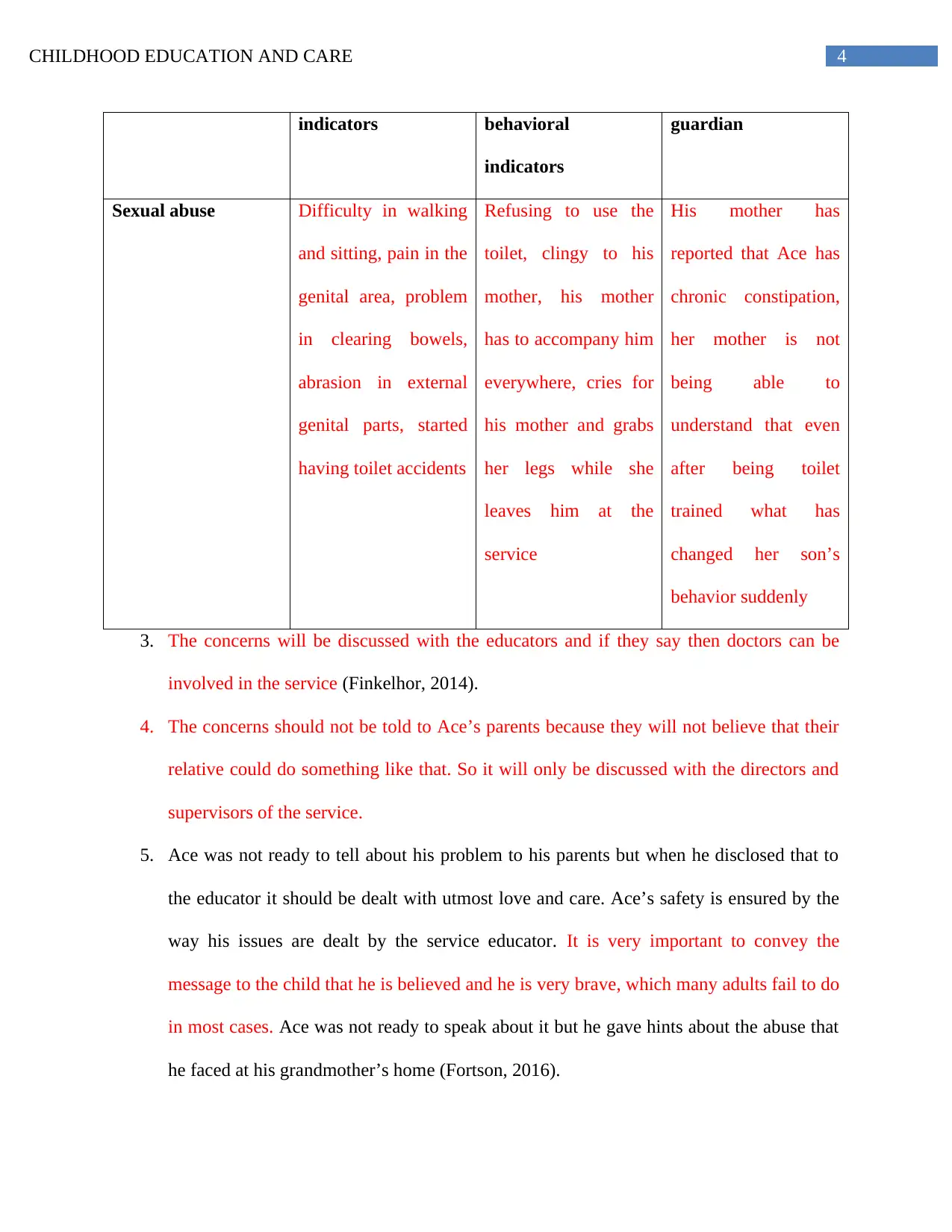
4CHILDHOOD EDUCATION AND CARE
indicators behavioral
indicators
guardian
Sexual abuse Difficulty in walking
and sitting, pain in the
genital area, problem
in clearing bowels,
abrasion in external
genital parts, started
having toilet accidents
Refusing to use the
toilet, clingy to his
mother, his mother
has to accompany him
everywhere, cries for
his mother and grabs
her legs while she
leaves him at the
service
His mother has
reported that Ace has
chronic constipation,
her mother is not
being able to
understand that even
after being toilet
trained what has
changed her son’s
behavior suddenly
3. The concerns will be discussed with the educators and if they say then doctors can be
involved in the service (Finkelhor, 2014).
4. The concerns should not be told to Ace’s parents because they will not believe that their
relative could do something like that. So it will only be discussed with the directors and
supervisors of the service.
5. Ace was not ready to tell about his problem to his parents but when he disclosed that to
the educator it should be dealt with utmost love and care. Ace’s safety is ensured by the
way his issues are dealt by the service educator. It is very important to convey the
message to the child that he is believed and he is very brave, which many adults fail to do
in most cases. Ace was not ready to speak about it but he gave hints about the abuse that
he faced at his grandmother’s home (Fortson, 2016).
indicators behavioral
indicators
guardian
Sexual abuse Difficulty in walking
and sitting, pain in the
genital area, problem
in clearing bowels,
abrasion in external
genital parts, started
having toilet accidents
Refusing to use the
toilet, clingy to his
mother, his mother
has to accompany him
everywhere, cries for
his mother and grabs
her legs while she
leaves him at the
service
His mother has
reported that Ace has
chronic constipation,
her mother is not
being able to
understand that even
after being toilet
trained what has
changed her son’s
behavior suddenly
3. The concerns will be discussed with the educators and if they say then doctors can be
involved in the service (Finkelhor, 2014).
4. The concerns should not be told to Ace’s parents because they will not believe that their
relative could do something like that. So it will only be discussed with the directors and
supervisors of the service.
5. Ace was not ready to tell about his problem to his parents but when he disclosed that to
the educator it should be dealt with utmost love and care. Ace’s safety is ensured by the
way his issues are dealt by the service educator. It is very important to convey the
message to the child that he is believed and he is very brave, which many adults fail to do
in most cases. Ace was not ready to speak about it but he gave hints about the abuse that
he faced at his grandmother’s home (Fortson, 2016).
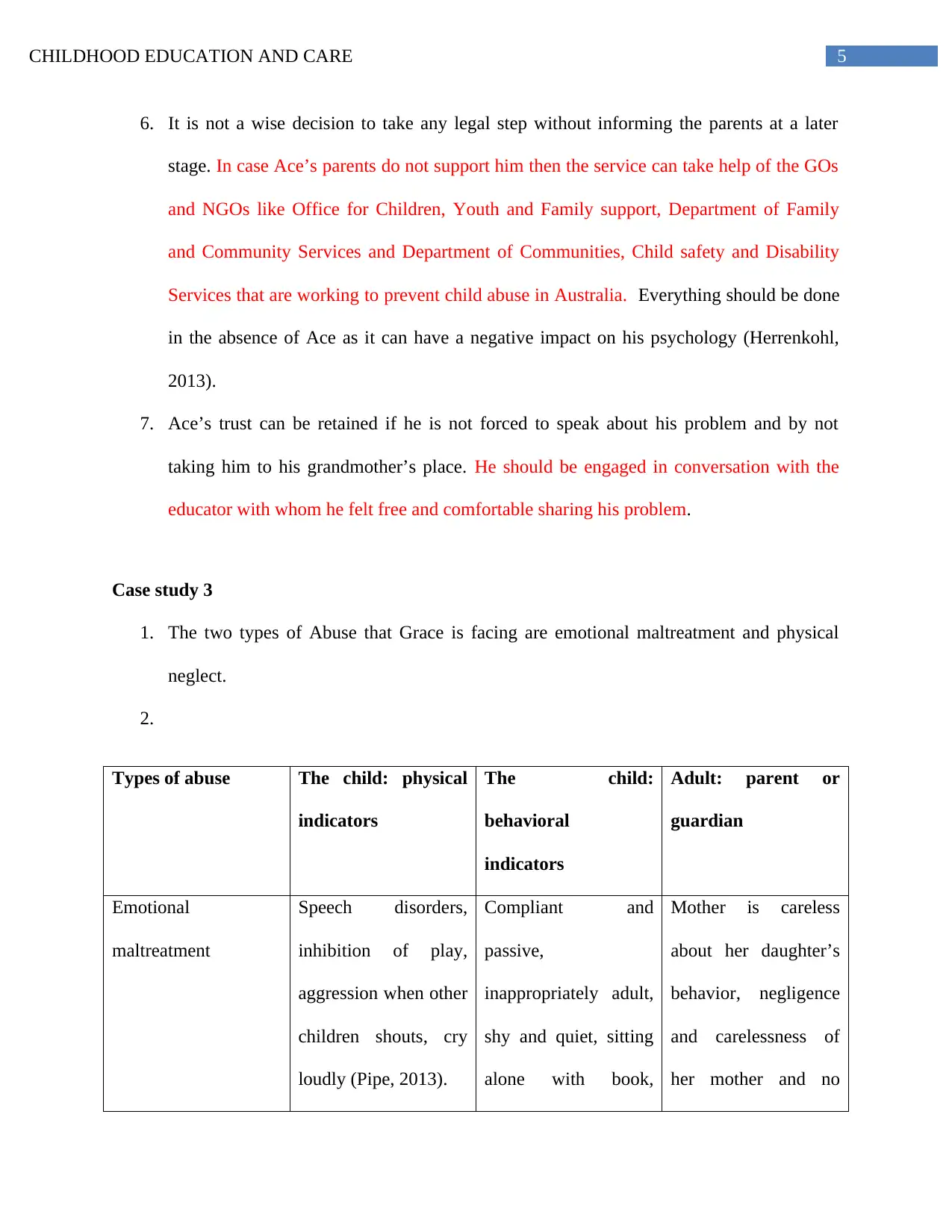
5CHILDHOOD EDUCATION AND CARE
6. It is not a wise decision to take any legal step without informing the parents at a later
stage. In case Ace’s parents do not support him then the service can take help of the GOs
and NGOs like Office for Children, Youth and Family support, Department of Family
and Community Services and Department of Communities, Child safety and Disability
Services that are working to prevent child abuse in Australia. Everything should be done
in the absence of Ace as it can have a negative impact on his psychology (Herrenkohl,
2013).
7. Ace’s trust can be retained if he is not forced to speak about his problem and by not
taking him to his grandmother’s place. He should be engaged in conversation with the
educator with whom he felt free and comfortable sharing his problem.
Case study 3
1. The two types of Abuse that Grace is facing are emotional maltreatment and physical
neglect.
2.
Types of abuse The child: physical
indicators
The child:
behavioral
indicators
Adult: parent or
guardian
Emotional
maltreatment
Speech disorders,
inhibition of play,
aggression when other
children shouts, cry
loudly (Pipe, 2013).
Compliant and
passive,
inappropriately adult,
shy and quiet, sitting
alone with book,
Mother is careless
about her daughter’s
behavior, negligence
and carelessness of
her mother and no
6. It is not a wise decision to take any legal step without informing the parents at a later
stage. In case Ace’s parents do not support him then the service can take help of the GOs
and NGOs like Office for Children, Youth and Family support, Department of Family
and Community Services and Department of Communities, Child safety and Disability
Services that are working to prevent child abuse in Australia. Everything should be done
in the absence of Ace as it can have a negative impact on his psychology (Herrenkohl,
2013).
7. Ace’s trust can be retained if he is not forced to speak about his problem and by not
taking him to his grandmother’s place. He should be engaged in conversation with the
educator with whom he felt free and comfortable sharing his problem.
Case study 3
1. The two types of Abuse that Grace is facing are emotional maltreatment and physical
neglect.
2.
Types of abuse The child: physical
indicators
The child:
behavioral
indicators
Adult: parent or
guardian
Emotional
maltreatment
Speech disorders,
inhibition of play,
aggression when other
children shouts, cry
loudly (Pipe, 2013).
Compliant and
passive,
inappropriately adult,
shy and quiet, sitting
alone with book,
Mother is careless
about her daughter’s
behavior, negligence
and carelessness of
her mother and no
⊘ This is a preview!⊘
Do you want full access?
Subscribe today to unlock all pages.

Trusted by 1+ million students worldwide
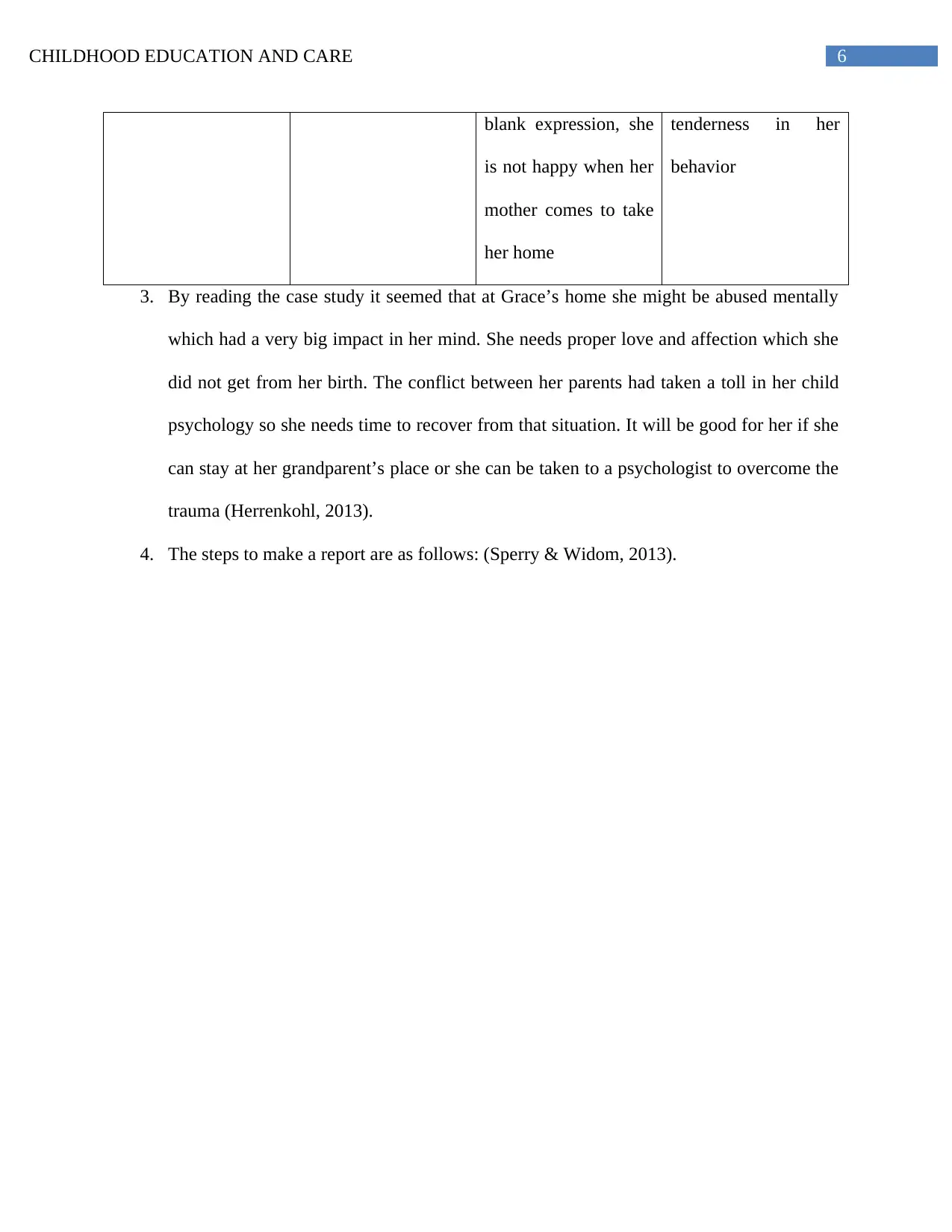
6CHILDHOOD EDUCATION AND CARE
blank expression, she
is not happy when her
mother comes to take
her home
tenderness in her
behavior
3. By reading the case study it seemed that at Grace’s home she might be abused mentally
which had a very big impact in her mind. She needs proper love and affection which she
did not get from her birth. The conflict between her parents had taken a toll in her child
psychology so she needs time to recover from that situation. It will be good for her if she
can stay at her grandparent’s place or she can be taken to a psychologist to overcome the
trauma (Herrenkohl, 2013).
4. The steps to make a report are as follows: (Sperry & Widom, 2013).
blank expression, she
is not happy when her
mother comes to take
her home
tenderness in her
behavior
3. By reading the case study it seemed that at Grace’s home she might be abused mentally
which had a very big impact in her mind. She needs proper love and affection which she
did not get from her birth. The conflict between her parents had taken a toll in her child
psychology so she needs time to recover from that situation. It will be good for her if she
can stay at her grandparent’s place or she can be taken to a psychologist to overcome the
trauma (Herrenkohl, 2013).
4. The steps to make a report are as follows: (Sperry & Widom, 2013).
Paraphrase This Document
Need a fresh take? Get an instant paraphrase of this document with our AI Paraphraser
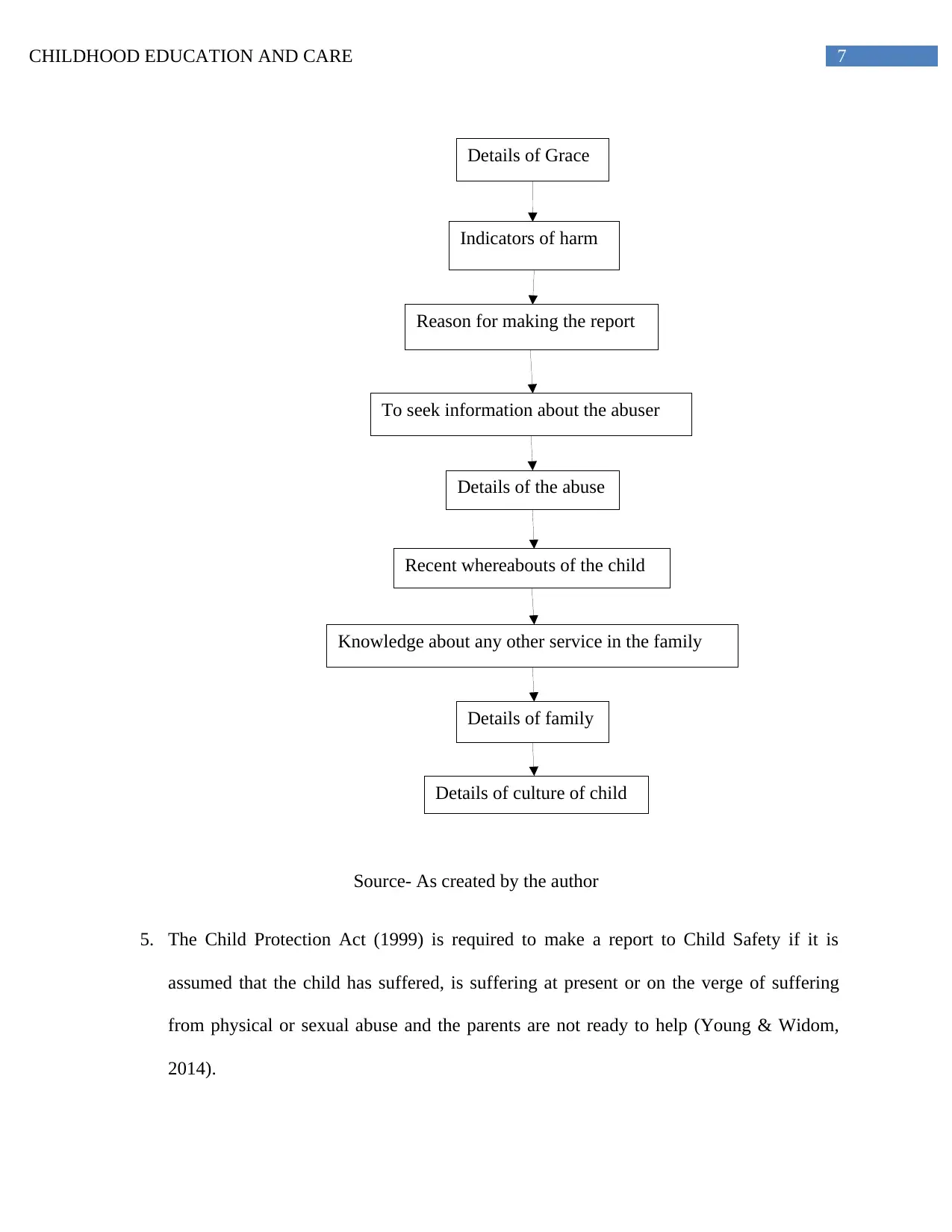
7CHILDHOOD EDUCATION AND CARE
Details of Grace
Indicators of harm
Reason for making the report
To seek information about the abuser
Details of the abuse
Recent whereabouts of the child
Knowledge about any other service in the family
Details of family
Details of culture of child
Source- As created by the author
5. The Child Protection Act (1999) is required to make a report to Child Safety if it is
assumed that the child has suffered, is suffering at present or on the verge of suffering
from physical or sexual abuse and the parents are not ready to help (Young & Widom,
2014).
Details of Grace
Indicators of harm
Reason for making the report
To seek information about the abuser
Details of the abuse
Recent whereabouts of the child
Knowledge about any other service in the family
Details of family
Details of culture of child
Source- As created by the author
5. The Child Protection Act (1999) is required to make a report to Child Safety if it is
assumed that the child has suffered, is suffering at present or on the verge of suffering
from physical or sexual abuse and the parents are not ready to help (Young & Widom,
2014).
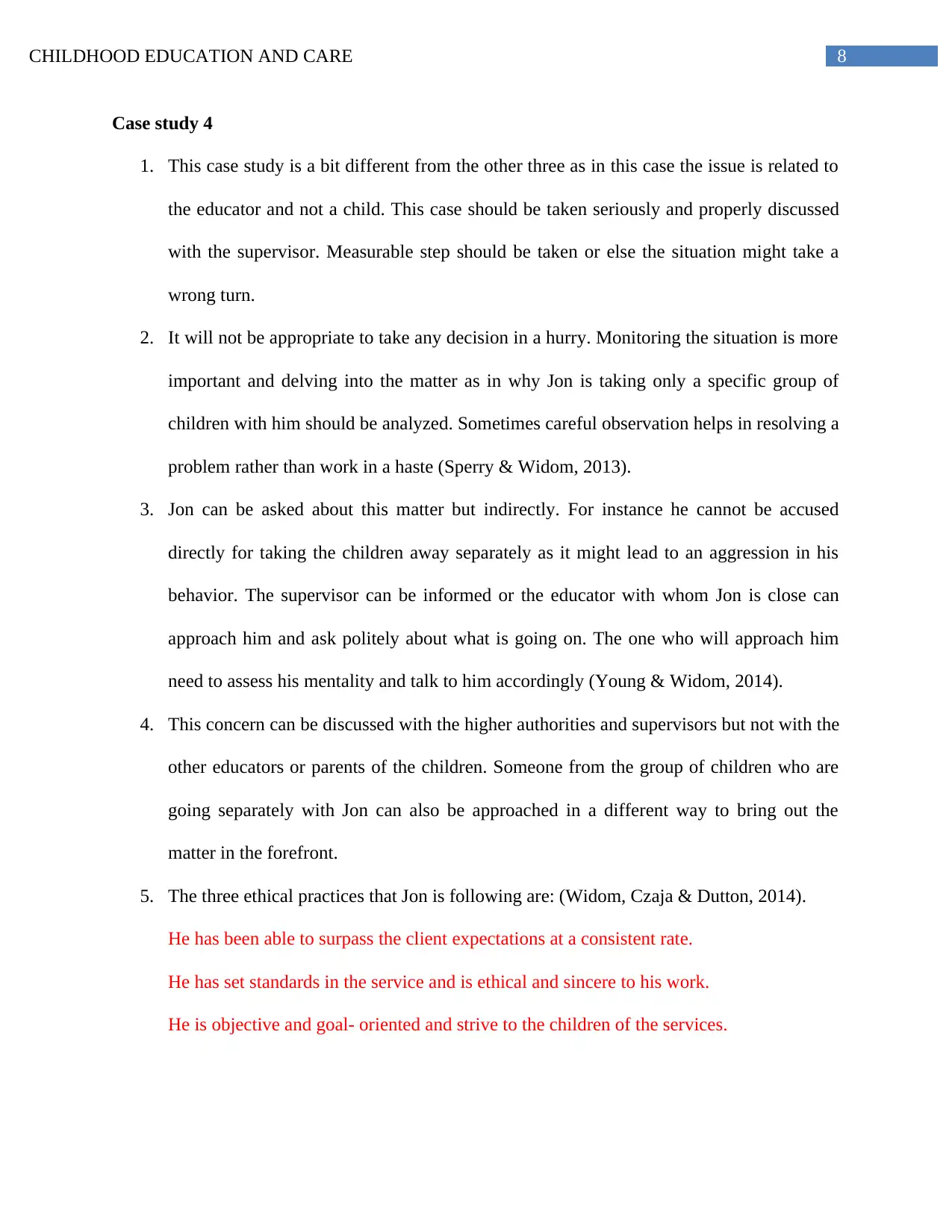
8CHILDHOOD EDUCATION AND CARE
Case study 4
1. This case study is a bit different from the other three as in this case the issue is related to
the educator and not a child. This case should be taken seriously and properly discussed
with the supervisor. Measurable step should be taken or else the situation might take a
wrong turn.
2. It will not be appropriate to take any decision in a hurry. Monitoring the situation is more
important and delving into the matter as in why Jon is taking only a specific group of
children with him should be analyzed. Sometimes careful observation helps in resolving a
problem rather than work in a haste (Sperry & Widom, 2013).
3. Jon can be asked about this matter but indirectly. For instance he cannot be accused
directly for taking the children away separately as it might lead to an aggression in his
behavior. The supervisor can be informed or the educator with whom Jon is close can
approach him and ask politely about what is going on. The one who will approach him
need to assess his mentality and talk to him accordingly (Young & Widom, 2014).
4. This concern can be discussed with the higher authorities and supervisors but not with the
other educators or parents of the children. Someone from the group of children who are
going separately with Jon can also be approached in a different way to bring out the
matter in the forefront.
5. The three ethical practices that Jon is following are: (Widom, Czaja & Dutton, 2014).
He has been able to surpass the client expectations at a consistent rate.
He has set standards in the service and is ethical and sincere to his work.
He is objective and goal- oriented and strive to the children of the services.
Case study 4
1. This case study is a bit different from the other three as in this case the issue is related to
the educator and not a child. This case should be taken seriously and properly discussed
with the supervisor. Measurable step should be taken or else the situation might take a
wrong turn.
2. It will not be appropriate to take any decision in a hurry. Monitoring the situation is more
important and delving into the matter as in why Jon is taking only a specific group of
children with him should be analyzed. Sometimes careful observation helps in resolving a
problem rather than work in a haste (Sperry & Widom, 2013).
3. Jon can be asked about this matter but indirectly. For instance he cannot be accused
directly for taking the children away separately as it might lead to an aggression in his
behavior. The supervisor can be informed or the educator with whom Jon is close can
approach him and ask politely about what is going on. The one who will approach him
need to assess his mentality and talk to him accordingly (Young & Widom, 2014).
4. This concern can be discussed with the higher authorities and supervisors but not with the
other educators or parents of the children. Someone from the group of children who are
going separately with Jon can also be approached in a different way to bring out the
matter in the forefront.
5. The three ethical practices that Jon is following are: (Widom, Czaja & Dutton, 2014).
He has been able to surpass the client expectations at a consistent rate.
He has set standards in the service and is ethical and sincere to his work.
He is objective and goal- oriented and strive to the children of the services.
⊘ This is a preview!⊘
Do you want full access?
Subscribe today to unlock all pages.

Trusted by 1+ million students worldwide
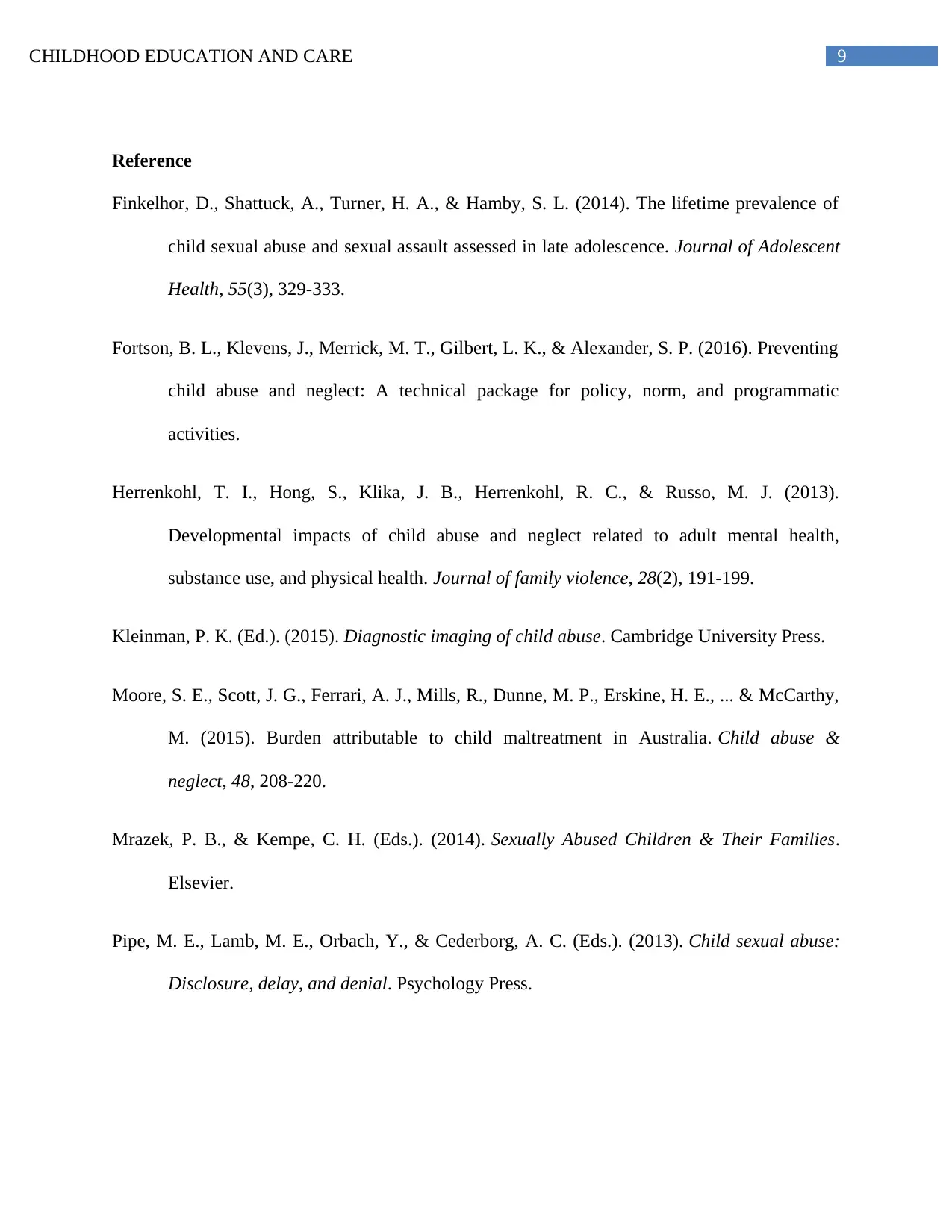
9CHILDHOOD EDUCATION AND CARE
Reference
Finkelhor, D., Shattuck, A., Turner, H. A., & Hamby, S. L. (2014). The lifetime prevalence of
child sexual abuse and sexual assault assessed in late adolescence. Journal of Adolescent
Health, 55(3), 329-333.
Fortson, B. L., Klevens, J., Merrick, M. T., Gilbert, L. K., & Alexander, S. P. (2016). Preventing
child abuse and neglect: A technical package for policy, norm, and programmatic
activities.
Herrenkohl, T. I., Hong, S., Klika, J. B., Herrenkohl, R. C., & Russo, M. J. (2013).
Developmental impacts of child abuse and neglect related to adult mental health,
substance use, and physical health. Journal of family violence, 28(2), 191-199.
Kleinman, P. K. (Ed.). (2015). Diagnostic imaging of child abuse. Cambridge University Press.
Moore, S. E., Scott, J. G., Ferrari, A. J., Mills, R., Dunne, M. P., Erskine, H. E., ... & McCarthy,
M. (2015). Burden attributable to child maltreatment in Australia. Child abuse &
neglect, 48, 208-220.
Mrazek, P. B., & Kempe, C. H. (Eds.). (2014). Sexually Abused Children & Their Families.
Elsevier.
Pipe, M. E., Lamb, M. E., Orbach, Y., & Cederborg, A. C. (Eds.). (2013). Child sexual abuse:
Disclosure, delay, and denial. Psychology Press.
Reference
Finkelhor, D., Shattuck, A., Turner, H. A., & Hamby, S. L. (2014). The lifetime prevalence of
child sexual abuse and sexual assault assessed in late adolescence. Journal of Adolescent
Health, 55(3), 329-333.
Fortson, B. L., Klevens, J., Merrick, M. T., Gilbert, L. K., & Alexander, S. P. (2016). Preventing
child abuse and neglect: A technical package for policy, norm, and programmatic
activities.
Herrenkohl, T. I., Hong, S., Klika, J. B., Herrenkohl, R. C., & Russo, M. J. (2013).
Developmental impacts of child abuse and neglect related to adult mental health,
substance use, and physical health. Journal of family violence, 28(2), 191-199.
Kleinman, P. K. (Ed.). (2015). Diagnostic imaging of child abuse. Cambridge University Press.
Moore, S. E., Scott, J. G., Ferrari, A. J., Mills, R., Dunne, M. P., Erskine, H. E., ... & McCarthy,
M. (2015). Burden attributable to child maltreatment in Australia. Child abuse &
neglect, 48, 208-220.
Mrazek, P. B., & Kempe, C. H. (Eds.). (2014). Sexually Abused Children & Their Families.
Elsevier.
Pipe, M. E., Lamb, M. E., Orbach, Y., & Cederborg, A. C. (Eds.). (2013). Child sexual abuse:
Disclosure, delay, and denial. Psychology Press.
1 out of 10
Related Documents
Your All-in-One AI-Powered Toolkit for Academic Success.
+13062052269
info@desklib.com
Available 24*7 on WhatsApp / Email
![[object Object]](/_next/static/media/star-bottom.7253800d.svg)
Unlock your academic potential
Copyright © 2020–2025 A2Z Services. All Rights Reserved. Developed and managed by ZUCOL.




